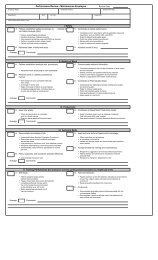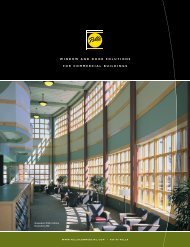Building Operating Management September 2011 - FacilitiesNet
Building Operating Management September 2011 - FacilitiesNet
Building Operating Management September 2011 - FacilitiesNet
You also want an ePaper? Increase the reach of your titles
YUMPU automatically turns print PDFs into web optimized ePapers that Google loves.
84<br />
buildingoperatingmanagement<br />
SEPTEMBER <strong>2011</strong><br />
HVAC<br />
Free Cooling:<br />
Don’t Let Savings<br />
Slip Away<br />
Understanding what goes wrong<br />
with airside economizers can help<br />
FMs ensure the systems operate at<br />
optimum effectiveness<br />
by dave moser<br />
Airside economizers are simple, effective systems<br />
that significantly reduce cooling energy use and<br />
improve indoor air quality. They increase the energy efficiency<br />
of the HVAC system so much that most energy<br />
codes require them for most commercial applications.<br />
Yet these systems are often neglected and, over time, can<br />
degrade to the point that they don’t operate correctly, resulting<br />
in energy waste. A little periodic maintenance can<br />
help keep them operating correctly.<br />
Sometimes referred to as “free cooling,” an airside<br />
economizer system consists of a set of outside and return<br />
air dampers that operate together to reduce the load on<br />
the mechanical cooling system. When outside air conditions<br />
are cool enough, the mechanical cooling can be<br />
shut off completely and the system can use outside air<br />
to cool the building, thus reducing the overall energy use<br />
of a facility. Indoor air quality is increased during airside<br />
economizer operation. That’s because a greater amount<br />
of ventilation air is provided to the occupied spaces than<br />
A recent PECI study showed that optimizing<br />
the performance of airside economizer systems<br />
is one of the most common and most cost-effective<br />
measures implemented as part of an existing<br />
building commissioning process, usually with a simple payback<br />
of less than one year. For more information, go to<br />
www.peci.org/documents/annex_report.pdf<br />
during minimum outside air mode.<br />
Airside economizers come in various different forms<br />
(e.g., temperature-based or enthalpy-based); they’re typically<br />
more cost-effective for larger buildings with a greater<br />
percentage of internal zones; and they may not make much<br />
sense in some climates, especially hot, humid climates.<br />
Return air dampers<br />
that are too big may<br />
not provide proper<br />
control because they<br />
lack adequate air<br />
velocity across them.<br />
The problem can be<br />
solved by blanking<br />
off a section of the<br />
dampers.<br />
These design considerations are important and have to be<br />
addressed, but design is only one side of the question of<br />
making airside economizers effective. If you already have<br />
an airside economizer system, how can you maintain it to<br />
keep energy costs down and indoor air quality high? The<br />
principles involved apply to small packaged HVAC systems<br />
as well as larger built-up air handling systems.<br />
Airside economizers operate behind the scenes, meaning<br />
that most occupants and sometimes operators do not<br />
sense whether an economizer system is working correctly<br />
or not. If it’s not working correctly, the main consequence<br />
is higher-than-necessary energy bills.<br />
How do airside economizers typically fail? What are<br />
the aspects that contribute to sub-optimal operation,<br />
and what can building operators do to address these issues<br />
and maintain proper performance? There are a wide<br />
variety of methods of maintaining performance, from<br />
periodic testing to trend data analysis. Here are some of<br />
the key issues to consider when it comes to airside economizer<br />
performance and maintenance.<br />
Dealing with Design and Construction Problems<br />
Some airside economizer systems are essentially<br />
doomed from the start, whether from sub-optimal design<br />
or improper construction. This is especially common for<br />
buildings that were not initially commissioned during construction.<br />
Common issues and their related fixes include:<br />
• Improper sensor type. In theory, enthalpy-based<br />
control of airside economizers is more energy efficient<br />
than temperature-based since enthalpy controls account<br />
for humidity. In practice, enthalpy sensors are especially<br />
prone to drift out of calibration — assuming they were<br />
ever calibrated properly to begin with — which can result<br />
in energy waste. Recent studies have shown that it may<br />
be more cost-effective to use temperature-based control<br />
when operation costs, maintenance costs and sensor error<br />
are considered along with energy benefits. If your sys-





